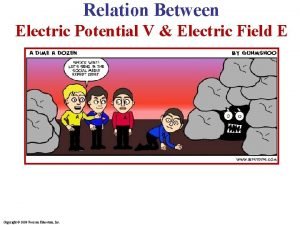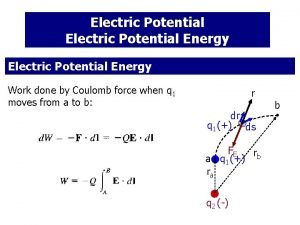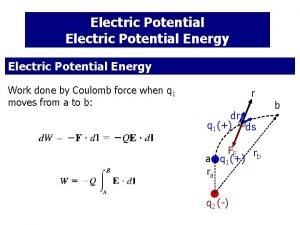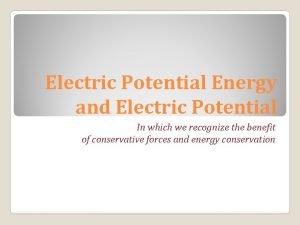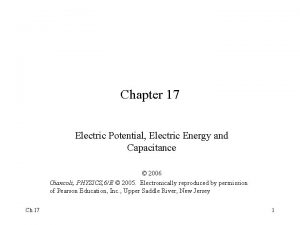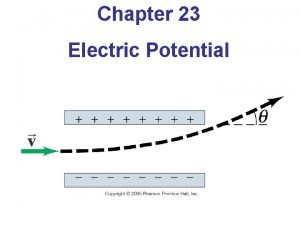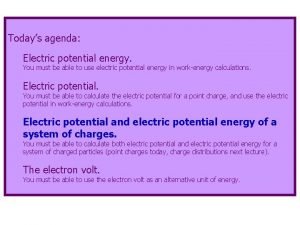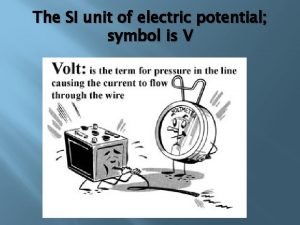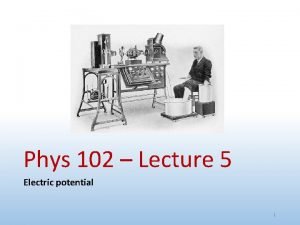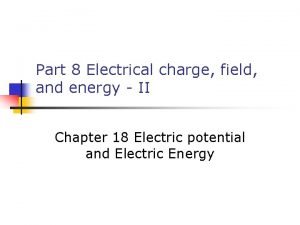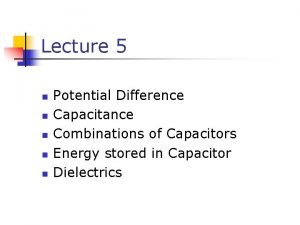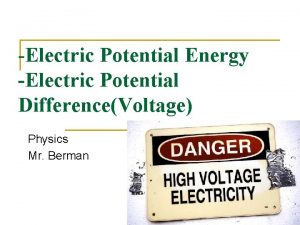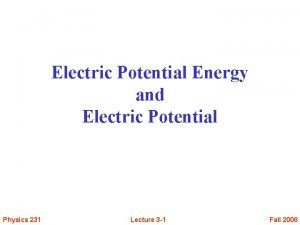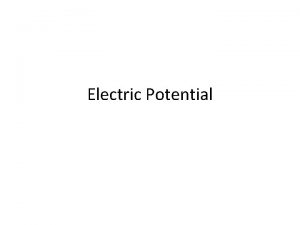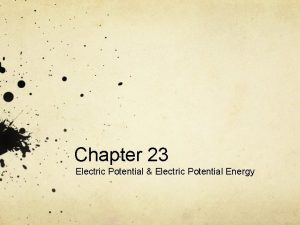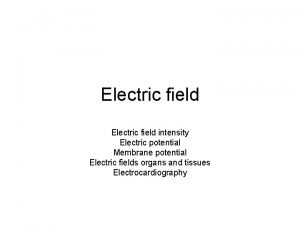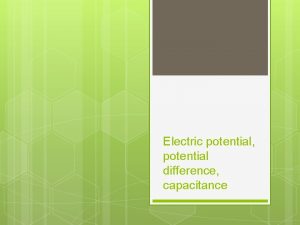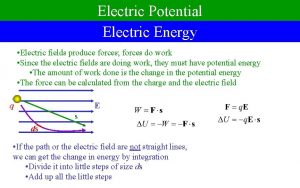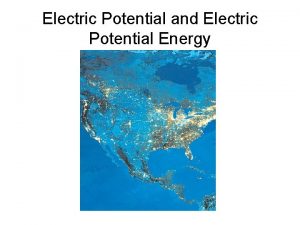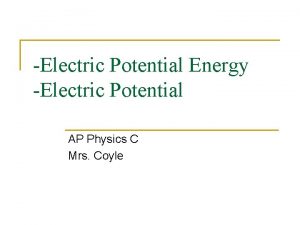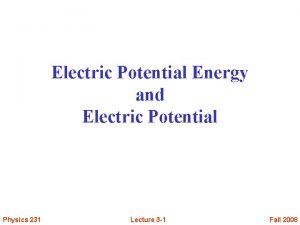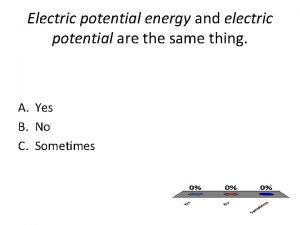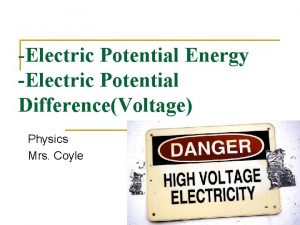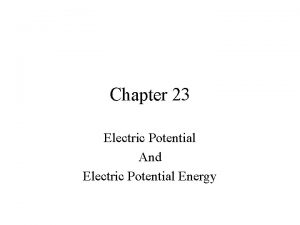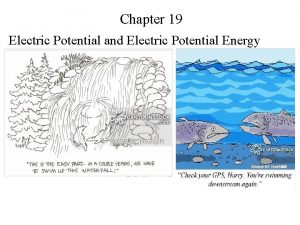Electric Potential Energy The electric potential energy of


























- Slides: 26

Electric Potential Energy The electric potential energy of charge q in a uniform electric field is where s is measured from the negative plate and U 0 is the potential energy at the negative plate (s = 0). It will often be convenient to choose U 0 = 0, but the choice has no physical consequences because it doesn’t affect ΔUelec, the change in the electric potential energy. Only the change is significant.

Analogy to Gravitational PE Gravitation PE depends on mass General Physics 2 Electric potential energy depends on charge Electric Potential 2


The Potential Energy of Point Charges Consider two point charges, q 1 and q 2, separated by a distance r. The electric potential energy is This is explicitly the energy of the system, not the energy of just q 1 or q 2. Note that the potential energy of two charged particles approaches zero as r .


Which set has a positive potential energy?

Which set has a negative potential energy?

EXAMPLE 29. 2 Approaching a charged sphere

EXAMPLE 29. 2 Approaching a charged sphere

The Potential Energy of a Dipole The potential energy of an electric dipole p in a uniform electric field E is The potential energy is minimum at ø = 0° where the dipole is aligned with the electric field. Remember p = qs

The Electric Potential We define the electric potential V (or, for brevity, just the potential) as Charge q is used as a probe to determine the electric potential, but the value of V is independent of q. The electric potential, like the electric field, is a property of the source charges. The unit of electric potential is the joule per coulomb, which is called the volt V:

The Electric Potential Inside a Parallel-Plate Capacitor The electric potential inside a parallel-plate capacitor is where s is the distance from the negative electrode. The electric potential, like the electric field, exists at all points inside the capacitor. The electric potential is created by the source charges on the capacitor plates and exists whether or not charge q is inside the capacitor.

Electric Potential Think of analogy with gravitational PE, where object with positive PE will fall if released. Here, p+ has high PE when near + plate and will “fall” toward negative plate when released Think of + charge when wondering if something is high or low potential + charges move from high to low potential

Electric Potential low PE High PE - - Unlike mass, charge can be + or -. Thus, PE depends on the sign of the charge. For example, an e- will have high PE when near the - plate and will “fall” toward the + plate when released - charges move from low to high potential

EXAMPLE 29. 7 A proton in a capacitor QUESTIONS:

EXAMPLE 29. 7 A proton in a capacitor

EXAMPLE 29. 7 A proton in a capacitor

EXAMPLE 29. 7 A proton in a capacitor

EXAMPLE 29. 7 A proton in a capacitor

EXAMPLE 29. 7 A proton in a capacitor

Electrostatic Potential & PE • When dealing with discrete point charges: Ve and Φ are scalars General Physics 2 F and E are vectors Electric Potential 21

The Electric Potential of a Point Charge Let q be the source charge, and let a second charge q', a distance r away, probe the electric potential of q. The potential energy of the two point charges is By definition, the electric potential of charge q is The potential extends through all of space, showing the influence of charge q, but it weakens with distance as 1/r. This expression for V assumes that we have chosen V = 0 to be at r = .

Electric Field & Equipotential Lines • Draw field lines and equipotential lines for the following charge distributions - General Physics 2 Electric Potential 23

Electric Field & Equipotential Lines • Draw field lines and equipotential lines for the following charge distributions + General Physics 2 Electric Potential 24


Equipotential Lines • connect points in space at same potential • equipotential surface is perpendicular to electric field lines General Physics 2 Electric Potential 26
 Electrical potential energy
Electrical potential energy Volts to ev
Volts to ev Expression for electric potential difference
Expression for electric potential difference Equipotential lines
Equipotential lines Electric potential
Electric potential Potential difference formula
Potential difference formula Electrostatic field formula
Electrostatic field formula Electric field and electric potential
Electric field and electric potential The relation between electric field e and potential v is
The relation between electric field e and potential v is Force is the integral of potential energy
Force is the integral of potential energy Work done by coulomb force
Work done by coulomb force Electric potential energy
Electric potential energy How to find electric potential energy
How to find electric potential energy Kinetic energy in electron volts
Kinetic energy in electron volts Formula energy
Formula energy Relation between potential energy and electric field
Relation between potential energy and electric field Potential energy of system of charges
Potential energy of system of charges Electric potential symbol and unit
Electric potential symbol and unit Electric potential energy
Electric potential energy Energy stored formula
Energy stored formula Electrostatic potential energy
Electrostatic potential energy Mgh si units
Mgh si units Electric potential energy
Electric potential energy Electrostatic energy
Electrostatic energy What is gravitational kinetic energy
What is gravitational kinetic energy Elastic potential energy
Elastic potential energy What is mechanical energy
What is mechanical energy








